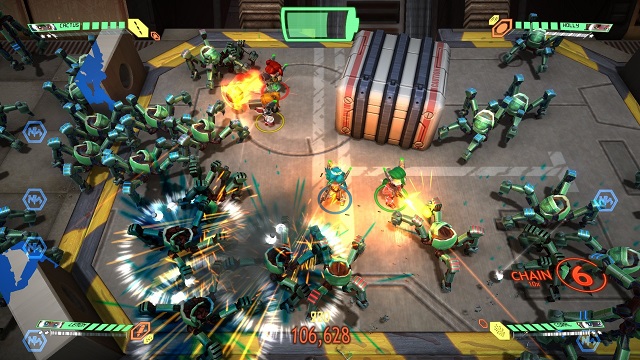I had an old Nintendo commercial moment while playing Assault Android Cactus at PAX East this year. You know, the kind where your life seems normal and then all of a sudden intense video game things are blowing your mind out the back of your skull. Pretty sure that best describes my experience with this twin stick shooter.
I love the approachability of most twin stick shooters, and how they never screw around before dumping you into the thick of things. Assault Android Cactus managed to do this even faster than most twin stick shooters do, dropping me into an arena that swiftly filled up with highly-animated, hostile robots. Like any game in this genre, I had to blast them to bits as fast as possible, but I could do so with a couple of different weapons depending on which character I chose. Cactus, the character the game’s named for, uses a machine gun, but other characters use shotguns and different weaponry to bring down the robot menace. There was a little something for anyone’s shooter style, and being an up close and personal kind of guy, I was instantly ripping robots to pieces with my shotgun.
You have a backup weapon that you can use as well, and these can be a something like a high-damage flamethrower or bomb to a temporary barrier that blocks shots and enemies. Again, players can go with whatever combo they like by choosing the character that uses that weapon combo. Get good with your build fast, though, because this game dumps so many robots on you at once. I’ve played games from this genre before, but never one that pushed me so hard so fast. If you’re playing with the local multiplayer, this somehow gets even crazier, filling the screen with shoulder-to-shoulder robots walking on every speck of space. On multiplayer, you’re practically just shooting them to have any room to walk on.
With that much craziness, you’re going to die, and that’s where the game’s neat battery system comes in. You have a battery symbol at the top of the screen that steadily drains, and you lose the level when it empties. Instead of having lives, dying just heavily drains the battery. Some enemies drop refills for it, so you’re going to want to grab them as fast as possible to stay alive. It seemed like it was a generous amount of power to play through each stage, but by the fourth level in the first world, I was dangerously low when I hit the stage’s end. You have to play fast and well if you want to see the game through to the end.
Not only are the enemies causing trouble, but some of the environments will shift and change as the stage moves on. Hunks of the ground will change places or drop out entirely, meaning you have to somehow keep track of your feet while dodging robots. It makes an already-challenging game even harder, adding to the havoc-filled dance of the gameplay. It’s a lot to keep track of, but with so much to watch and shoot, it’s impossible to turn away from once you start playing it. Hopefully no one wants to talk to you while you play it, as you won’t even acknowledge that they’re there.
It’s beyond sharp for a game in early access. There are already a bunch of levels for you to play, and the devs from Witch Beam are clearly hard at work on a game they love. It’s a solid game that’s worth the asking price in its current state, so you should definitely take Assault Android Cactus for a spin. Just don’t do it if you have anything else important to do that day. Whatever you need to do won’t get done once you start this game up.





